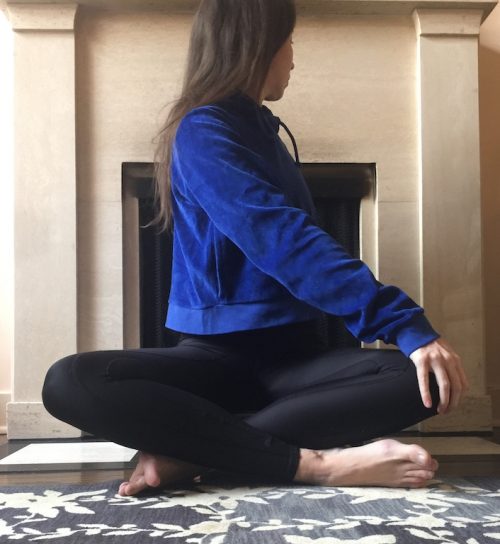BY ALICE YORK
This time of sheltering in place is as good as any to allow your life to let life be a little quieter and slower—to turn down the volume and pace just a little bit. Fast and loud certainly have their time and place, but why not let yourself be a little softer with your expectations and the pressure you put on your body for the time being?
This doesn’t mean to be completely sedentary, just perhaps with a little bit more lightness in how you move through life. If you are someone who craves high intensity, honor that desire but balance it out by alternating going hard with being soft: take a pause between heavier activity days with gentler movement. However you incorporate the following suggestions, be it as a standalone or supplement to your existing routine, allow these poses to become staples in your quarantine life and beyond.
FORWARD FOLD
Any type of forward folding should be a must-do in your day. This position not only stretches the spine and hamstrings but helps to release the muscles of the lower back and aid in digestion (when you make contact with the front of the torso with the tops of the thighs, the compression helps to get digestive juices flowing). But the real key component here is the back: our spines are designed more as clotheslines (east-west, flexible), like our ape ancestors who travel on all fours, rather than telephone poles (north-south, rigid). It takes a lot of effort to stay erect. We’re always working against the weight of gravity, which takes a toll on our spines. Forward folding helps us to let the spine work with gravity instead and let all that effort and tension start to melt away.
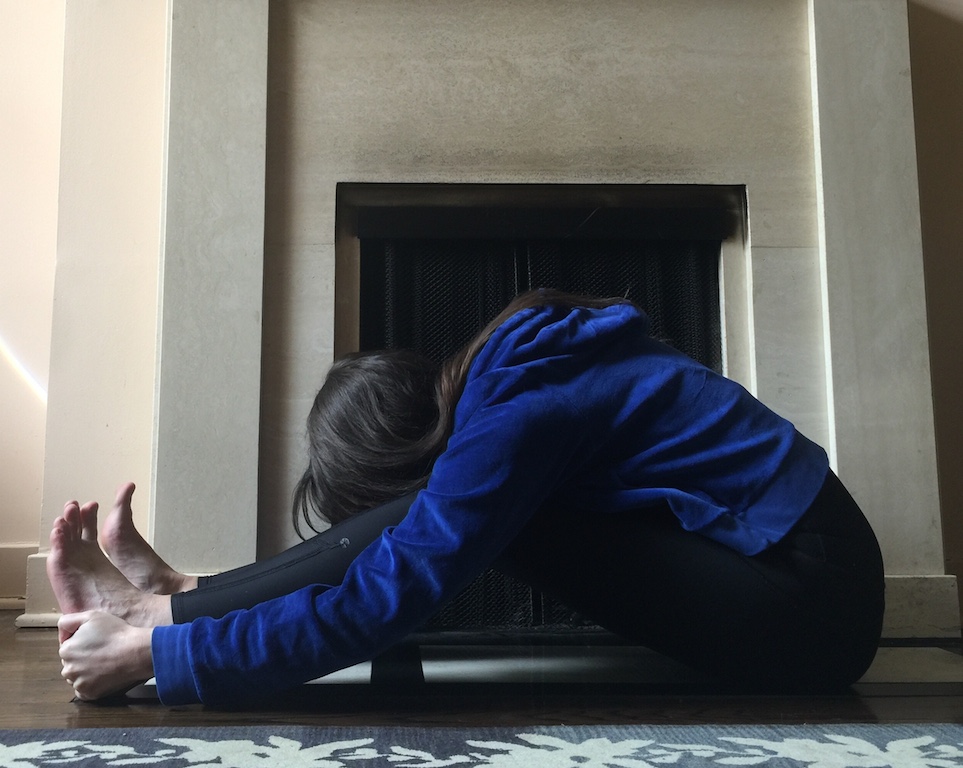
A forward fold can be done standing up or seated. When standing, feet can be hip-distance apart or slightly wider for more comfort, the knees with a nice, soft bend. Breathe in, and on your exhale, fold over the legs, letting the spine unfurl. Let the chest and stomach make contact with the thighs. Arms can hang long or you can take opposite elbows with the hands. Allow the arms to sway, the hips to sway—the idea is for this to feel really loose and easy, like a release. Let the head be heavy and feel the crown of the head pulled towards the floor like a magnet. Feel the soles of the feet push down into the floor below you so you can revolve your sits bones up towards the ceiling. Picture your inhale rising up the backs of the legs, and the exhale sliding down the back towards the head, releasing from the crown of the head. Stay for at least 1-2 minutes.
If you are seated, extend the legs out in front of the body, feet flexed and knees bent. Peel the flesh out from under the sits bones and behind you. You should be seated at the front of the sits bones, long in the waist, with a feeling of forward momentum, kind of like a ski jumper. Lift the arms above you as you inhale and as you exhale, fold over the legs. Hands can grasp the lower legs, ankles, or around the foot. Heavy the head. Make contact with the front of the torso and tops of the thighs. Breathe into the back. Stay like this for 2-5 minutes, letting yourself travel inward and tune out the outside world.
LEGS UP THE WALL
This is one of my favorite yoga positions. Spread out a mat, blanket, or towel perpendicular to a wall or lie on your bed if it is adjacent to the wall on any side. You can place a pillow or bolster against the wall at the base. Sit on one hip with your seat close to the wall—if incorporating a bolster or pillow, you should be off to one side of this prop—and roll over onto the back (and atop the pillow, if applicable), your seat close to the wall and your legs now extended up the wall. There is no real graceful way to enter into this, so know you’re not alone if you feel clunky or awkward getting into this pose.
Choose a comfortable position of your arms, either at your sides, resting your palms on the stomach, or extend the arms into a “T” or a cactus or goal post position (the latter two variations also an opener for the chest and shoulders).
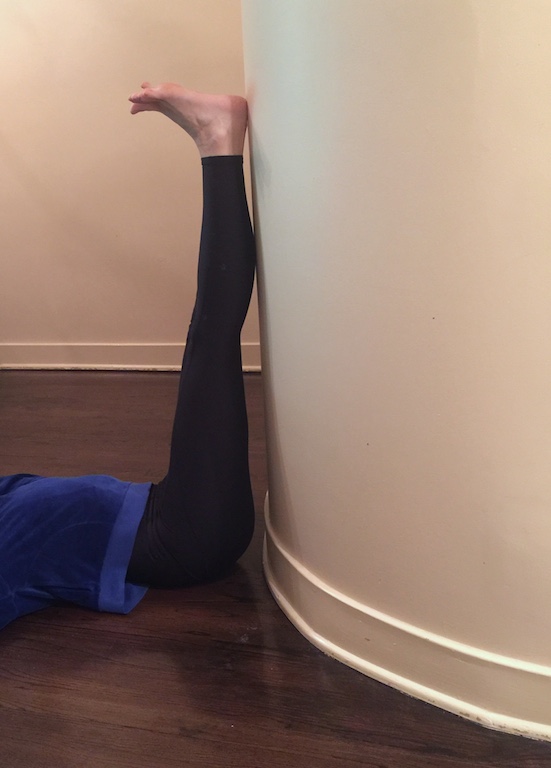
Lifting the legs above the heart helps to counteract the effects of the standing upright, our legs working hard to move us and support us, and our blood traveling and pooling downward. Legs up the wall is a really relaxing posture and brings comfort to tired legs at the end of the day. This is also great after a lot of travel, be it a long drive or flight, or sitting all day at work.
SPINAL TWIST
Twisting the spine assists with mobility and flexibility of the spine and its surrounding muscles. The compressive nature of a twist is also thought to aid in digestion and in detoxification of the organs, helping to remove any waste or clearing up stagnation. A twist can also help in stress reduction and reducing back pain.
Add a combination of seated and supine twists into your routine. Sitting on the floor or on a chair or couch (or anywhere!), let one hand come to the right knee and the other behind the back, revolving the torso to the right. Keep the collarbones wide and the spine tall. Inhale and lift the crown of the head higher, exhale and twist a little deeper. Repeat on the other side.
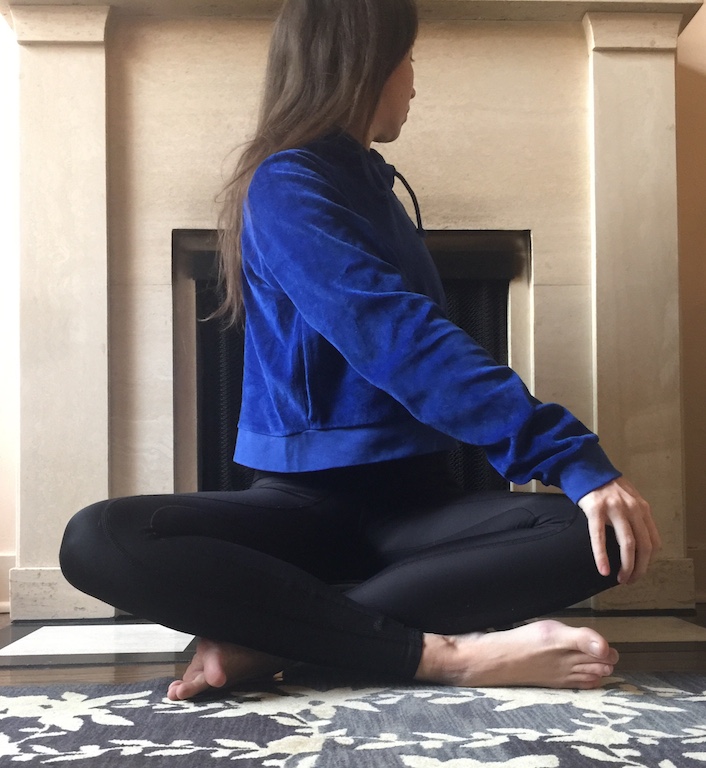
Lying on the back, bend the knees and walk the feet wide, scoot the hips slightly to the right, and let the knees drop to the left. The arms can be out wide in a “T” or in a goal post or cactus position, elbows bent. Let the head gently roll to the right. For a deeper stretch, bring the outside of the left ankle to the outer right knee. Repeat on the other side.
STRETCHING THE “NECKS” OF THE BODY
Our bodies have intelligent patterning to them. In addition to the neck that supports our head, we also have our ankles and wrists that are like smaller versions of the neck. These areas tend to have a lot of buildup of tension as they do a lot of work for us. Stretching and lengthening these areas can bring a lot of release to the body and help unblock the passage of blood and air.
For the ankles: Lying on your back, lift your right leg up to the ceiling, bringing the hands to the back of the right thigh. The left knee can be bent with the left foot planted, or it can be extended out long on the floor, foot flexed, for more challenge. Point and flex the right foot. Make circles with the foot one direction and the other. This helps lubricate the ankle joint. Repeat on the other side.
For the wrists: Come onto hands and knees, in tabletop position. Wrists are stacked under the shoulders, knees under the hips. Flip the wrists, so the fingers point back towards the body. The palm is flat to the floor. Pulse forward and backward, opening the inner wrist. This is really great for all the tightness we get from being on our phones and computers. If this is too intense, do one hand at a time. If that is too much, just let the fingers point out to the sides, rather than back towards the body—if you do the latter, let your movement be side-to-side, rather than front-to-back.
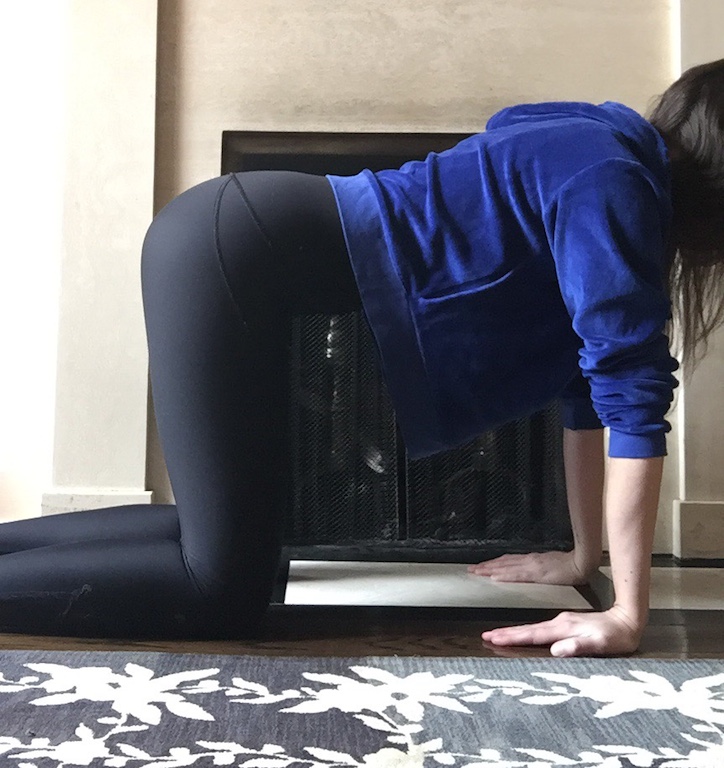
For both ankles and wrists at the same time: Lie on the back and lift the arms and the legs in the air (the knees can have a bend to them). You’ll look and feel a little like a dead bug. Start to wiggle the hands and feet, letting the arms and legs get very loose. It might feel silly or strange, but stick with it. Make circles with the feet and hands, bringing life to the ankle and wrist joints. Shake it all out! Feel bouncy and free! Take a few cycles of breath afterwards with the legs extended long on the ground and arms resting at your sides, or whatever variation lets you settle and relax comfortably on your back.
For the neck: Seated or standing, bow the head forward, tucking the chin to the chest. Feel the length in the back of the neck. Stay here for at least a few slow cycles of breath. Roll the head over to the right, right ear in line with the right shoulder. Extend the left arm out at a 45-degree angle. Let the right hand rest on the left ear/side of the head and give a gentle tug. There will be a stretching and lengthening sensation along the left side of the neck and into the top of the shoulder. Stay for at least a few breaths, letting the muscles of the face soften, and the shoulders melt away from the ears. Repeat on the other side.
For all of these poses, I recommend setting the tone of relaxation by letting the lighting be soft, maybe even lighting a candle or two, playing some calming music (or finding a really quiet spot), and choosing a setting that is conducive to relaxation. Make it a ritual rather than a chore!
***
Alice York is a yoga and meditation instructor and lifestyle and wellness writer living in Chicago. Her biggest focus is removing the barrier to entry and the intimidation factor to yoga and meditation practices, making them fun and accessible for all levels, ages, and bodies. To learn more about her current teaching schedule online or to book a virtual private session, send any inquiries to alicemyork@gmail.com.



